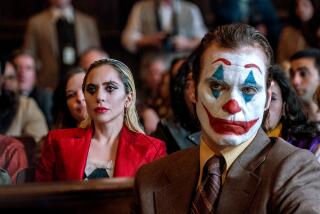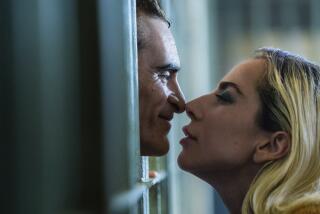The peril of leaping off the pages
Anyone who grew up reading comic books knows that it wasn’t just the outlandish plots that captivated us; comics resonated because they explored the dualities of lonely nerds unleashing their heroic alter egos. For the most part, comic book movies have struggled to strike the right balance of roller-coaster thrills and astute characterizations.
The “Spider-Man” franchise may prove to be the exception. “Spider-Man 2,” which landed in theaters yesterday, is poised to scale box office heights this weekend, joining its already lucrative and popular predecessor, “Spider-Man,” as a commercial success. Neither is perfect, but critics have largely embraced them, and they do achieve a balance between human proportion and superhuman spectacle that all comic book movies aspire to.
For the record:
12:00 a.m. July 7, 2004 For The Record
Los Angeles Times Wednesday July 07, 2004 Home Edition Main News Part A Page 2 National Desk 1 inches; 42 words Type of Material: Correction
Spider-Man -- A photo caption accompanying an article about comic book heroes in Thursday’s Calendar Weekend section said the Spider-Man character originated in the first issue of the comic book series “The Amazing Spider-Man.” He first appeared in “Amazing Fantasy” No. 15.
The first benefited from a delicious setup and actors who could really act, though it degenerated into bloated action-movie theatrics in the second half. “Spider-Man 2” screenwriter Alvin Sargent (the Academy Award-winning writer of “Julia” and “Ordinary People”) loads the movie with psychodrama; and the absence of the larky humor that David Koepp supplied in the first “Spider-Man” is particularly acute. But Tobey Maguire, who plays Spider-Man and his alter ego Peter Parker, and the other returning players -- Kirsten Dunst, as girl next door Mary Jane Watson; James Franco as Harry Osborn, friend to Peter and enemy to Spidey; and Rosemary Harris as Peter’s Aunt May -- lend both comfort and class to the enterprise. In addition, Sam Raimi’s follow-up to his first film has a more complex and commanding villain in Alfred Molina’s Dr. Octavius and more dazzling special effects.
Looking back, the first “Superman” movie in 1978 had an appealing prologue set in Smallville, which succeeded in capturing the alienation of the adolescent Clark Kent. It reached its action-movie peak in the scene when Superman made his first appearance rescuing Lois Lane from a damaged helicopter, but then it got bogged down in a cheesy plot (featuring a hammy Gene Hackman as archvillain Lex Luthor) and an overly convoluted conclusion.
“Superman II,” smoothly directed by Richard Lester, improved on the original. It had better villains in the trio of meanies (led by Terence Stamp) from the planet Krypton, and charming interplay between Christopher Reeve and Margot Kidder, though it too suffered from a numbing, overlong finale. After that, the series sank into third-rate camp, and filmmakers have been trying for years to revive the franchise.
Their box office notwithstanding, the four “Batman” movies were largely a bust, despite some striking visual designs and a couple of good villains. Jack Nicholson in the first movie and Michelle Pfeiffer in the second provided welcome flashes of wit that was otherwise in short supply. The first two movies, directed by Tim Burton, were dark and lumbering, while the next two, directed by Joel Schumacher, went to the opposite extreme of featherweight foolishness. They kept trying to touch a psychological nerve in exploring Bruce Wayne’s tortured background, but they never engaged us in his journey. Maybe the problem was that the “Batman” films never found a viable leading man. Michael Keaton, Val Kilmer and George Clooney all failed to discover the human being beneath the tight-fitting costume.
More recently, the two “X-Men” movies offered some of the intriguing psychological dimensions that the “Batman” movies lacked, but the action sequences needed more oomph to match the appealingly twisted characterizations.
The misguided movie version of “The Hulk” placed so much emphasis on the psychological torment of the lead character, locked in an Oedipal battle with his father, that it never got around to plucking any fun from the genre. The effects that turned the anguished hero (Eric Bana) into a not-so-jolly green giant were downright cheesy.
Other recent comic book movies, “Daredevil” and “The Punisher,” were hurt by less-than-inspired casting. They followed the predictable path of choosing hunky, square-jawed actors -- Ben Affleck and Tom Jane, respectively -- to play their superheroes, which meant they were cursed with blandness.
The first shrewd decision “Spider-Man” made was to cast gifted maverick actors to play the crime-fighters and damsels in distress. Another bonus was that Raimi, a veteran of B-movies, refused to take himself or his enterprise too seriously. While both films catch the poignancy of an adolescent hero wrestling with his isolating superpowers, they inject enough humor to leaven the angst. Look at the scene in “Spider-Man 2” when Spidey temporarily loses his ability to sling and swing and has to take an elevator to get down from the top of a skyscraper. He has an awkward encounter with a man who enters the elevator with him and inquires about his costume; an embarrassed Maguire confides that it doesn’t fit right in one spot. The fact that the other inhabitant of the elevator is played by Hal Sparks, who plays a gay man obsessed with comic books on Showtime’s “Queer as Folk,” adds a sly touch of irony -- as well as an insouciant hint of homoeroticism. Raimi has the nerve to be playful in a big-budget summer epic.
Raimi retains his sense of humor in the thrilling action scenes. The kidnapping of Aunt May by the tentacled Dr. Octavius is the equal of the helicopter rescue in the first “Superman.” When Aunt May uses her umbrella for leverage in the death-defying chase up the side of a building, the touch adds just the right note of quirkiness to what might have been an impersonal set piece. And it’s worth saluting the elegance and tender gravity that Harris brings to a sometimes disreputable genre.
I don’t want to oversell the virtues of “Spider-Man 2.” It’s not going to be challenging “Citizen Kane” or “The Godfather” in the American film pantheon. But it’s refreshing to see a summer blockbuster that doesn’t insult the audience’s intelligence. These days we live in a world of two movie businesses that rarely overlap. Audiences that flock to heavily hyped “tent-pole” or “franchise” movies shun the provocative indie films that appeal to the cognoscenti.
This is a shame, because most of us who are movie lovers grew up savoring giddy Hollywood spectacles (before they went really stupid) as well as brainy foreign films. But now there’s a polarization at the movies, just as there is in so many other parts of American society. So it’s nice to find a movie that bridges the gap.
If fans of “In America” or “Monster” or “Eternal Sunshine of the Spotless Mind” happen to wander into the multiplex to catch “Spider-Man 2,” they’ll be able to enjoy themselves without hating themselves in the morning. For a couple of hours at least, an unpretentious brand of populism rules.
*
Supersize comics
Some of the predecessors to “Spider-Man” movies proved more heroic than others.
REEVE: The second time was the charm for Superman.
KEATON: Moody “Batman” couldn’t make up his mind.
JACKMAN: As “X-Men” films’ Wolverine, Hugh looked sharp.
ERIC BANA: So big. Too much. Cheesy “Hulk” effects.
AFFLECK: “Daredevil”: Square-jawed or just square?
More to Read
The biggest entertainment stories
Get our big stories about Hollywood, film, television, music, arts, culture and more right in your inbox as soon as they publish.
You may occasionally receive promotional content from the Los Angeles Times.










